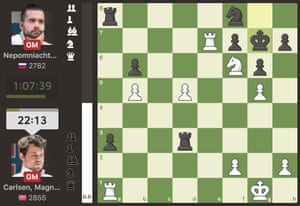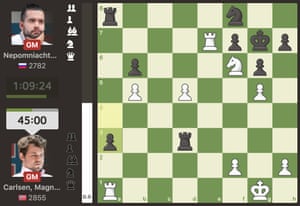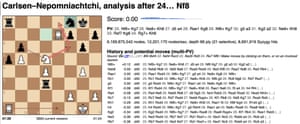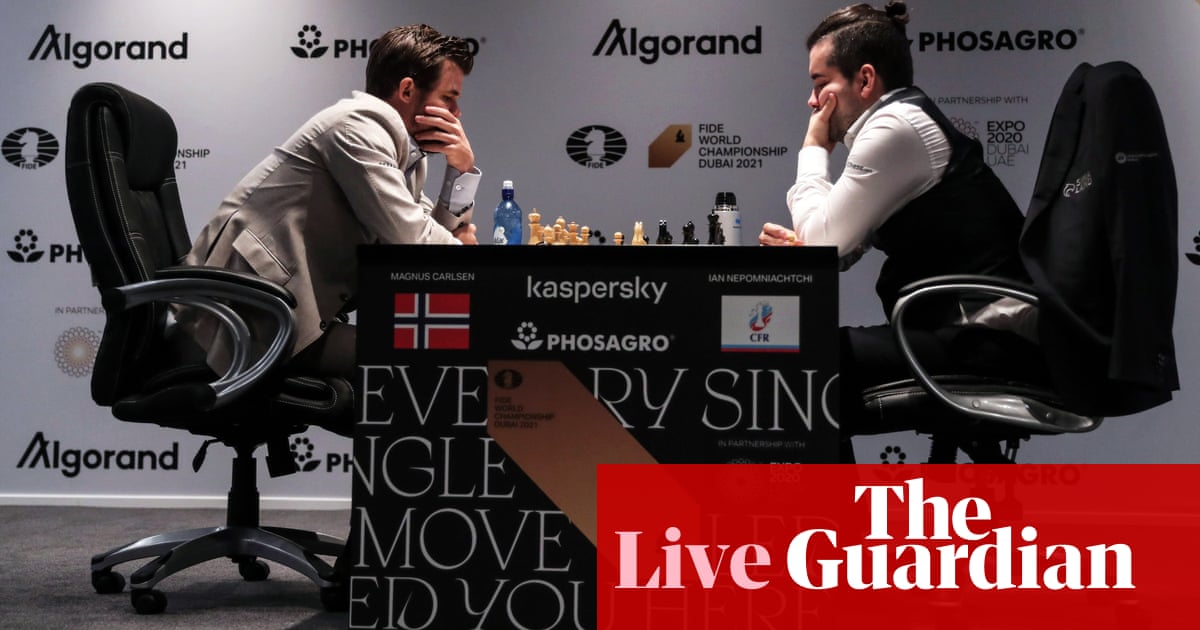That’s all for Tuesday’s live coverage. Thanks as always for following along with us. Be sure check shortly for a full report off today’s fourth game.
At the close of the presser, Carlsen is informed that he shares a birthday with Winston Churchill. Asked if he believes he shares any qualities with the former PM, he says: “There was this quote from Churchill on one of his opponents, that he was a very modest man and he had great reasons to be modest. So I would say for (Nepomniachtchi), he is not a modest man and with good reason.”
Both players are asked whether the current format is the best way to determine the world chess champion. “It’s hard to say because I believe the importance of traditions in chess is really big,” Nepomniachtchi says. “I guess whatever works you shouldn’t try to make it work better in order not to break it. I believe this system with the matches is more or less fair.”
Says Carlsen, who’s spoken on multiple occasions about changing the format: “There’s a saying that if you don’t have anything nice to say, you shouldn’t say anything at all. So I’m going to invoke that particular saying right here.”
Carlsen is what he was hoping for out of 18. Nh4!?, the first new move of today’s game. “There are insanely complicated lines,” he says. “The approach that (Nepomniachtchi) chose is not the only one that black can choose. In other variations it’s insanely complicated and really, really risky for black. To be honest, the one he chooses, it looks really, really risky to leave the knight on f8 and bank everything on the a-pawn. If you’ve miscalculated something, you just lose without any chances. But it’s a lot easier of course when you’ve studied it and you know that it’s a draw and you can kind of work it out from there. But believe me, there are many, many other options for black that lead to much more complications than what happened in the game.”
He continues: “I think what he did was just very sensible. An approach that looks a bit dubious at first since your knight is going to be a bit locked in, but with concrete calculation you can make it work and that’s how you usually solve your opening problems. You try to avoid the lines where you have to remember everything and try to choose something that you can sort of remember the main points.”
Carlsen is asked whether he felt like today’s peaceful result feels like a setback. “It’s OK,” he says of the fourth straight draw. “I’ve started with a lot more draws than this [in the 2016 and 2018 world title matches]. When you play a forced line as today, you don’t expect to hit very often. But the idea is to hit once in a while, take your opponent by surprise, and the other times you’ve usually got to be very safe.
“Obviously I would have loved to win, would have loved to find more chances than I did, but I think overall it’s a normal result against a world-prepared opponent.”
Nepomniachtchi is asked whether he felt like he was in any difficulty during today’s game. “The line which happened should be known by many who play Petrov,” he says. “It’s one of the lines which is quite principled. Despite this, I believe (18. Nh4!?) is a very interesting try. Perhaps I even want to play this as white one day. But in general the task was more about not to mix up things and not to do something stupid, because as far as I know this line is more or less safe for black. Of course I was checking twice everything and also calculating a lot, but in general I think this is quite safe.”
Asked whether the half-point is a satisfying result, the challenger is to the point: “Since I played Petrov, indeed.”
Asked again whether he was surprised by Nepomniachtchi’s Petrov, Carlsen re-states that it was one of the openings he was well-prepared for. “It was one of the main openings that I expected seeing that he played it in the Candidates and also, in the first black game, he went for a more classical approach rather than a sharp one,” he says. “So it was very much expected. Couldn’t know obviously which exact Petrov line he was gong to go for, but the Petrov in itself was very much expected.”
Asked to expound on the opening in general, Carlsen doesn’t have much to offer. “What can I say?” he says. “I tried something concrete and it didn’t work. But that’s I think a normal result. I didn’t expect him to have missed the line that I played completely but, yeah, in some other iterations there can be a lot of difficult decisions to make for black. But I think the way that he played, there was just ... there are some different tries but there’s just nothing. State of modern chess. Not much else to say.”
Asked about all the time he spent on moves in the endgame when a draw appeared likely – more than 22 minutes on 25. Nf6+ and nearly 35 minutes on 30. Ne8+ – Carlsen said he was simply being thorough in his hunt for winning chances that even he suspected were not there.
“I think it sometimes happens at world championships that you work a lot before the match and you work a lot during the match on openings and such and somehow this makes you work less over the board,” he says. “My approach was very clear there that I didn’t think particularly that I had anything, but I had two hours for the game so I should spend them all looking for whatever chances could be found.”
At the post-game press conference, Carlsen is asked whether playing on his 31st birthday affected his approach or mindset. “I would have of course loved to have had a rest day on the eve of my birthday so I could have had at least a token celebration. Apart from that, I would say it’s pretty good. I think I won at least one game in the World Cup against (Farrukh) Amonatov in 2005. And obviously the match in 2016 was decided on my birthday in the tiebreak. It’s going to take a lot for me to have bad reflections of me playing on my birthday, even though I lost to (Wesley) So last year.”
“This Bc3 instead of Qb7 is a little bit rare,” says Carlsen moments after stepping out of the studio. “This whole plan, it’s pretty dangerous for him. The computer shows theories in many lines, but practically it’s not so easy. I thought what he went for looked a bit dangerous, but I couldn’t see it so I assume it was just a draw.”
Carlsen is asked whether he was frustrated during those long thinks in the endgame.
“I wouldn’t say I was frustrated,” he says. “I was just trying and I didn’t find it. It seemed pretty normal.”
He also brushes off the notion that he was surprised by Nepomniachtchi’s Petrov: “He played it in the Candidates so it was one of the main openings to prepare for.”
Carlsen plays 32. Ne8+ after more than 14 minutes. Nepomniachtchi takes one minute before answering with 32. ... Kg8. It’s the moment of truth for Carlsen: if he retreats his knight we’re looking at a draw by repetition. And that’s what he opts for: 33. Nf6+. That leaves Nepomniachtchi with only one correct move (Kg7), which is a draw. He stops the clock to inform the arbiter before making it on the board and Game 4 is in the books as a draw after 33 moves and two hours and 37 minutes!
Chess.com (@chesscom)♔ @MagnusCarlsen and @lachesisq reach a draw in game 4 and discuss the game. #CarlsenNepo pic.twitter.com/zlofPRbU1f
November 30, 2021
Carlsen has been inspecting this position for the last 10 minutes. The champion is look for some way, any way to extend what’s been a dry encounter compared to the first three contests.

Carlsen finally goes with 30. Ne8+ after 34 minutes. Nepomniachtchi responds with the essentially forced 30. ... Kg8. The Norwegian plays 31. Nf6+ and the challenger answers with 31. ... Kg7. The champion is back on the clock. If he plays Ne8+, we’re likely looking at a draw. That might be his course, rather than complicating matters in search of a winning chance, given the considerable time advantage of more than 67 minutes (and counting) for Nepomniachtchi.
Another very long think for Carlsen, 23 minutes and counting. He’s under 45 minutes on the clock with 11 moves until the time control.

Carlsen ends up playing 28. Nf6+ and Nepomniachtchi answers with 28. ... Kg7. And The Norwegian immediately opts for 29. g5. He’s playing for a win. The challenger responds with 29. ... a3 after three and a half minutes.
Nepomniachtchi plays the automatic 27. ... a4, spending more than seven minutes. Several plausible responses for Carlsen, including Kf1, Nf6+ and g5. Meanwhile, Chess.com’s broadcast transitions to a break with these hot bars from freestyle rapper and YouTuber Harry Mack.
Carlsen takes nearly eight minutes before deciding on 27. d5. By declining the draw by repetition (Nf6+), it’s a statement of intent from the world champion that he’s still going to try for the win.
“I think personally that there is a trap somewhere and Magnus with his time usage is setting it up,” Dutch grandmaster Anish Giri says. Carlsen plays 25. Nf6+ to put black’s king in check after more than 22 minutes of deep thought. Nepomniachtchi runs away from the check with 25. ... Kg7, the only feasible option as Kh8 is losing. Nepomniachtchi returns with 26. Kg8. The engines suggest there’s no way for Carlsen to gain an advantage from this position. Will he play a move that complicates it to perhaps create an opening?
Carlsen has been on the clock for 20 minutes and counting. The engines suggest that bringing his knight forward to put white’s king in check is best (Nf6+), though another option is taking white’s pawn on the queenside (Nxb6).
Fabiano Caruana, who played the Petroff in the sixth and 11th games of his world championship match with Carlsen three years ago, has been speaking extensively about the opening on Chess.com’s broadcast. “I thought that the most logical thing for Ian would be to play the Berlin,” Caruana says. “That seemed like a natural choice for him in case Magnus were to play 1. e4. But the Petroff is interesting. I really did not expect this.”
Nepomniachtchi spends more than 10 minutes before initiating the exchange of dark-squared bishops (21. ... Bxf4 22. Nxf4). An exchange of pawns follows (22. ... Rxc3 23. Nxd5). More quick moves follow (23. ... Rd3 24. Re7 Nf8) and now Carlsen settles in for his first lengthy think of the game. The Norwegian supercomputer Sesse evaluates the position as dead even.

Incredibly, both players appear to still be in their opening preparation after 19. ... Nd7 20. Ng2 Rfc8 21. Bf4. This is particularly remarkable considering that many of these positions haven’t included many forced moves but several viable options. Nepomniachtchi is on the clock but he’s stepped away from the board. Carlsen’s head is in his hands as he looks over the board, calculating the variations. A quick draw today would might be a half-point on paper, but it would no doubt feel like a setback for Carlsen playing with the favored white pieces.
The queens are off the board after the next series of moves (13. ... b6 14. cxd5 cxd5 15. Qb5 Qd7 16. a4 Qxb5 17. axb5). Nepomniachtchi, who’s spent five more minutes of clock in the early stages, plays 17. ... a5. The many early exchanges suggest this encounter will fizzle out to a draw, though Carlsen answers immediately with the unusual 18. Nh4!?. Says grandmaster Judit Polgar in the commentary booth following 18. ... g6 19. g4: “It’s quite amazing how concrete it’s going to become so fast.”

Nepomniachtchi takes more than two minutes before playing 8. ... c6. Carlsen quickly answers with 9. Re1 and the challenger answers with 9. ... Bf5. Carlsen then bypasses the more popular Qc2 for 10. Qb3. More quick moves follow: 10. ... Qd7 11. Nc3 Nxc3 12. Bxf5 Qxf5 13. bxc3. Still no major surprises, though Dutch grandmaster Anish Giri notes on the Chess24 broadcast that Carlsen’s last move has historically led to many draws.
Carlsen, wearing a white blazer on his 31st birthday, opens with 1. e4 and it’s no Sicilian for Nepomniachtchi, who answers with 1. ... e5. And the challenger is going with the popular, solid Petrov Defence (2. Nf3 Nf6). A minor surprise as he’s not known for playing it, although he did in the Candidates Tournament. The players fly through their opening moves (3. Nxe5 d6 4. Nf3 Nxe4 5. d4 d5 6. Bd3 Bd6 7. O-O O-O 8. c4) before Nepomniachtchi steps away from the board.
Carlsen will be playing with the white pieces for today’s Game 4. Asked following Sunday’s third game what the difference-maker will be in a match that’s been played on level terms so far, the Norwegian said: “It’s three games in. There’s a lot of time to go and as you saw [on Saturday], it could have easily been a decisive result. Obviously, for each game the most likely result is a draw. Saying otherwise would be quite disingenuous. But any game could explode. Not today.”
Will today be the day?
Interestingly, Carlsen has not held the lead in the classical stage of a world championship match in more than seven years, since he first defended the title in a 2014 rematch with Vishy Anand. In 2016, he fell behind Sergey Karjakin with a Game 8 defeat before prevailing in Game 10 to force a series of quickfire tie-breakers, which he went on to win. In 2018, he played to 12 consecutive draws with second-ranked Fabiano Caruana before retaining the title on tie-breakers once again.
For Monday’s rest day, our Sean Ingle took a closer look at why there are so few women’s players in the upper echelons of chess. There is not a single active woman’s player in the top 100 now that Hou Yifan of China, who is ranked 83rd, is focusing on academia.
For Carlsen, the subject was “way too complicated” to answer in a few sentences, but suggested a number of reasons, particularly cultural, were to blame. Some, though, still believe it is down to biology. As recently as 2015 Nigel Short, vice-president of the world chess federation Fide, claimed “men are hardwired to be better chess players than women,” adding: “You have to gracefully accept that.”
That claim raises the eyebrows of the greatest female chess player, Judit Polgar, who was ranked as high as No 8 in the world and, amusingly, has a winning record against Short. “It is not down to biology,” she tells the Guardian. “It’s just as possible for a woman to become the best as any guy. But there are so many difficulties and social boundaries for women generally in society. That is what blocks it.”
Polgar, who defeated 11 current or former world champions in either rapid or classical chess, including Garry Kasparov and Magnus Carlsen, before retiring in 2014, believes that an early start, encouraging girls to think big, and better teaching are crucial factors. “All champions and big players start to play chess and get familiar with the game at a pretty early age,” says the Hungarian grandmaster, who is now a commentator on the website Chess24.
Hello and welcome back for the fourth game of the World Chess Championship. We’re back following Monday’s rest day after draws in Game 1, Game 2 and Game 3 that were notable for longtime champion Magnus Carlsen making early pawn sacrifices in exchange for long-term initiative. In each of those contests, Ian Nepomniachtchi’s opening material advantages ultimately didn’t hold up and he was forced to rely on accurate endgame play to emerge with a result.
For those of you just coming aboard, Carlsen, who celebrates his 31st birthday today, has been at No 1 in the Fide rankings for 10 straight years and was considered the world’s best player even before he dethroned Viswanathan Anand for the title in 2013. Nepomniachtchi, also 31, is ranked No 5, having earned his place at the table by winning the eight-man candidates tournament in April with a round to spare. It’s the culmination of a rivalry that started nearly two decades ago when they first met across the board as boys at the 2002 European Under-12 Championship in Peniscola, Spain. Notably, Nepomniachtchi enters the title tilt with a winning lifetime record against Carlsen in classical matches (four won, one lost and eight drawn). That makes him unique among today’s top players, even if two of those victories came in youth championships.
The best-of-14-games match is taking place at the Dubai Exhibition Centre with the winner earning a 60% share of the €2m ($2.26m) prize fund if the match ends in regulation (or 55% if it’s decided by tie-break games, as happened in Carlsen’s second and third title defenses).
We’re a little more than 40 minutes from today’s first move, so not much longer now.
Bryan will be here shortly. In the meantime here’s his report from Sunday’s third game from Dubai.

